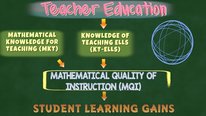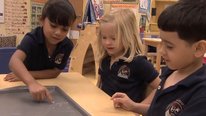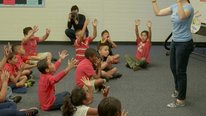- Johannah Nikula
- Visual Access to Mathematics: Supporting Teachers of English Learners
- http://mathandlanguage.edc.org
- Education Development Center
- Pam Buffington
- http://ltd.edc.org/people/pam-buffington
- Senior Managing Project Director
- Visual Access to Mathematics: Supporting Teachers of English Learners
- http://mathandlanguage.edc.org
- Education Development Center
- Mark Driscoll
- Visual Access to Mathematics: Supporting Teachers of English Learners
- http://mathandlanguage.edc.org
- Education Development Center
- Peter Tierney-Fife
- Visual Access to Mathematics: Supporting Teachers of English Learners
- http://mathandlanguage.edc.org
- Education Development Center
Public Discussion
Continue the discussion of this presentation on the Multiplex. Go to Multiplex










Gerald Kulm
Senior Professor
Hi. Thanks for the overview of the project. Are the activities used with the teachers the same ones they will use with EL students? How will teachers be supported as they begin to implement the ideas in their classrooms?
Mark Driscoll
Gerry: good to hear from you. We are still in first-year design of the VAM course, getting ready for pilot beginning in August. The mathematics activities we intend to use will be of both types: teachers-only and teachers-students. The latter will be used, in good part, to gather EL student-work artifacts, for use in analysis in the course. Implementation supports will include lesson/activity planning routines, several sets of guidelines on introducing visual representations and language support/production strategies, and, we hope, some online support from peers.
Regards,
Mark
M. Alejandra Sorto
Very timely project as teachers need to develop skills to support all students, especially those developing academic English language. You mentioned in the video that you will incorporate strategies for language access and language production, I was wondering what are these strategies and how are they integrated in the mathematical tasks/activities.
Johannah Nikula
The focus in this course for teachers on mathematical visual representations is one way that we discuss support for both access and production because visual representations can support students to make sense of a mathematical task and can also support them in explaining their mathematical thinking. We are also including several targeted language support strategies that can be woven into lessons. One example to support language access is the 3 Reads strategy, in which students hear or read a mathematics task multiple times with a different focus during each reading to help them make sense of the task and the task language. One example to support language production is use of a co-constructed word bank in which both teacher and students contribute important and/or confusing words and phrases that relate to the mathematics task, and then the teacher asks students to use particular words or phrases from that co-developed bank during their work and mathematical explanations for that task. Of course, these and other strategies can and should be differentiated or tailored in different ways depending on the particular strengths and needs of students working on a mathematics task.
We would love to hear about strategies that you and others have found productive to integrate into mathematics lessons to support language access and production.
Andrew Izsak
We were very excited to see that you, too, are using both the multiple batches and variable parts perspectives on proportional relationships. We are also using both perspectives with preservice middle grades and secondary grades teachers. Have you found differences in what is more and less accessible to teachers when using each of the perspectives?
Andrew, Sybilla, and Torrey
Mark Driscoll
Truth be told, we have been strongly influenced by your thoughtful and thought-provoking JRME article. That said, we are still in first-year design mode, with feedback from a group of Maine and Massachusetts mathematics and ELL specialists. Hence our findings are limited so far. We will pilot our course starting in August, and hope to gather more information about the two perspectives then.
Regards,
Mark
Michelle Perry
Researcher
Thanks for the project overview. How is the online portion of the course structured? Are there opportunities for interaction and/or collaboration among participants?
Johannah Nikula
The course includes 8 online sessions, which are mostly asynchronous and will include tasks such as mathematics task explorations, readings about language access and production, reflections on instruction, and analysis of student work. Discussion boards with prompts for reflection and discussion are one means for interaction, and we’ve been working on how best to prompt and facilitate interactive discussion in that format. In addition, we are including periodic opportunities to meet in real-time in small groups using videoconferencing combined with interactive whiteboards (e.g., to share mathematical approaches) and participants have really appreciated these opportunities to interact. We are still developing the course and are interested to hear if others have suggestions about the best ways to foster interaction and collaboration in an online course session.
Jorge Solis
Thank you for sharing this work! There is a great need for more support of novice and inservice teachers around mathematics content and language development with ELLs. I was wondering if and how the course addresses the assessment of mathematical reasoning with students from different English language proficiencies?
Mark Driscoll
Jorge: Our project is focused on teacher learning and not directly on EL student reasoning (indirectly through teacher analysis of student work). We may gain some insight into evidence of EL student reasoning at different language proficiency levels, but the project is not designed to use direct assessment.
Regards,
Mark
Jorge Solis
Thanks Mark. Again, I think you’re working on very important work increasing access to mathematics. Focusing on teaching learning and development of skills and dispositions for promoting access mathematics is critical! What have been some challenge or issues you’ve noticed in teachers acquiring target skills and dispositions?
Mark Driscoll
Thank you, Jorge. As you know, some circumstantial challenges are difficult for individual teachers to manage—-for example, classrooms in which many different languages are represented among newcomer students. Such challenges require systemic supports for the teacher and students. Considering the kinds of challenges that seem more manageable within the classroom, some we’ve noted are: overall unfamiliarity with mathematical visual representations used as thinking tools; an associated instructional commitment to rush students to symbolic/algebraic representations; lack of attention to indicators of proficiency and potential in (EL) student thinking; and lack of commitment to and/or lack of time for comparisons in class of different student approaches to tasks (which can be helpful to EL students, especially). We believe pressures of time in lessons influence all of these, but also believe that use of instructional routines in class and analysis of student work outside of class, can help.
Regards,
Mark
Jeffrey Barrett
Great work! It is good to see how visual representations and thinking about mathematics can be leveraged in a way that supports students learning language at the same time.
Peter Orne
A real strength of this video is the many visual representations of the work!
Further posting is closed as the showcase has ended.